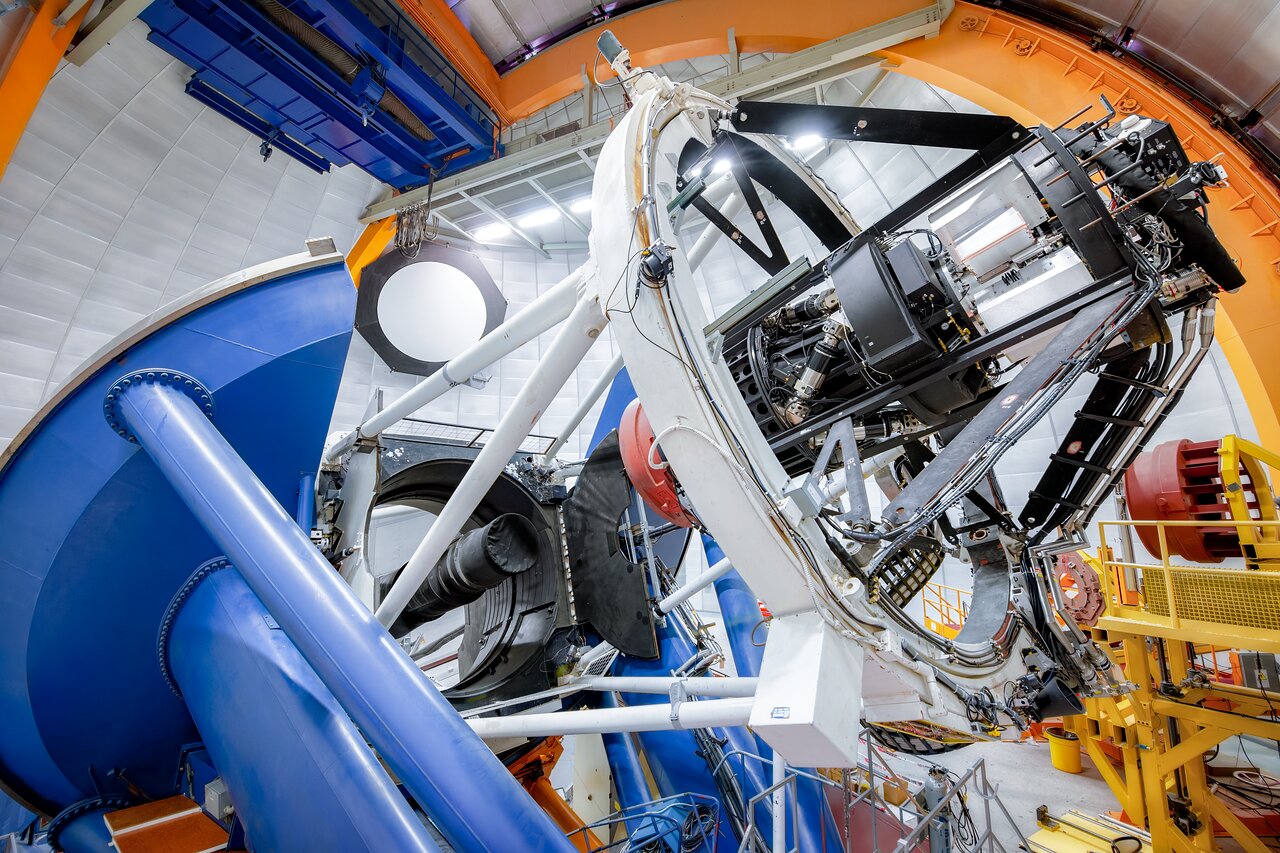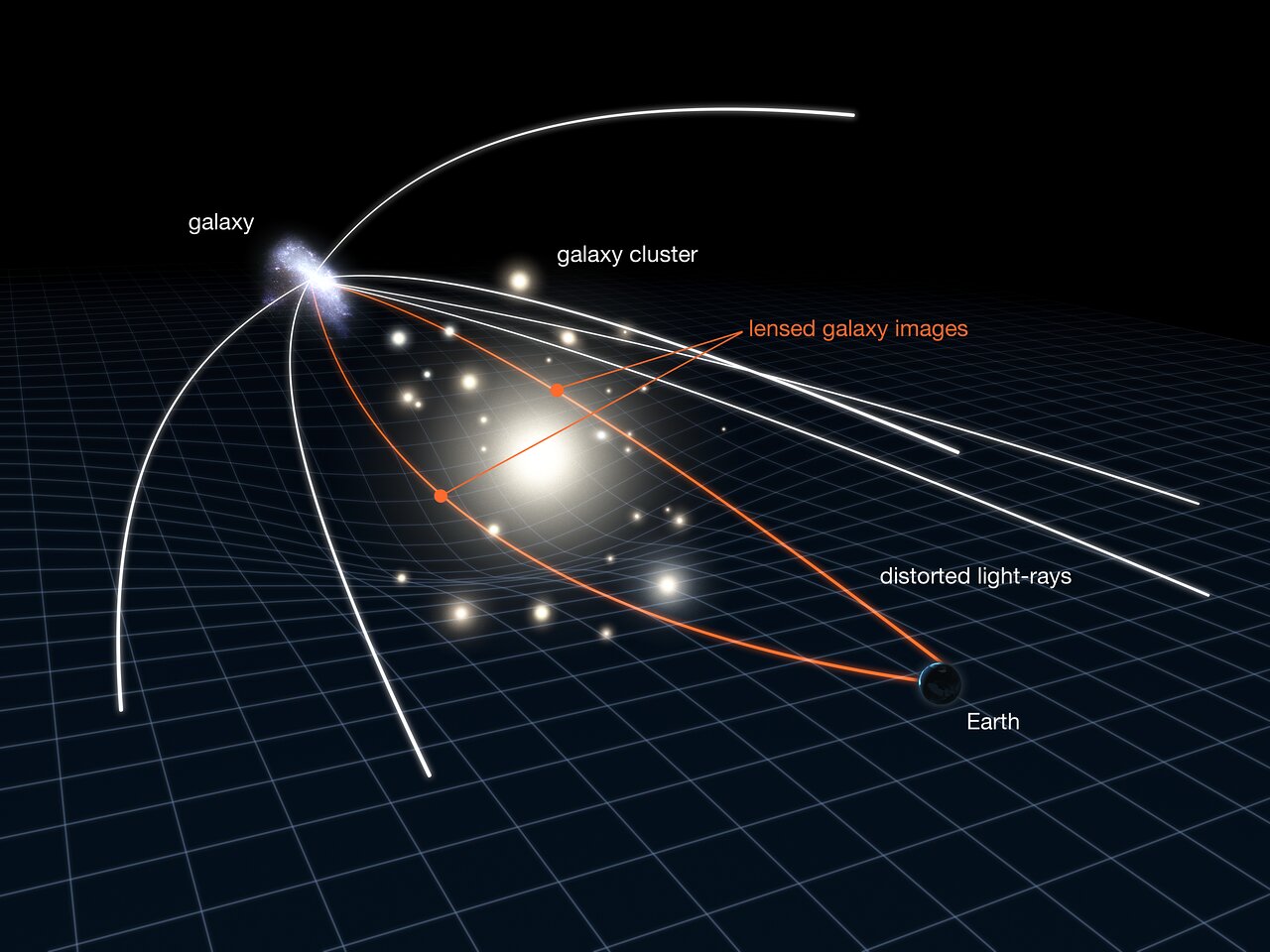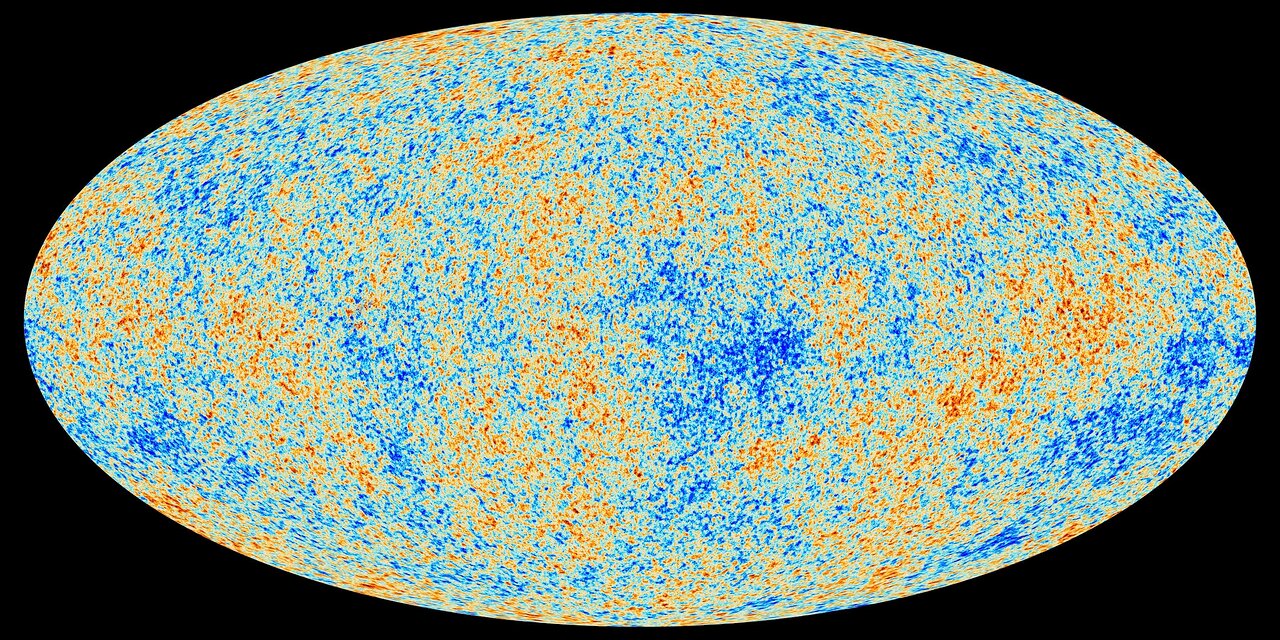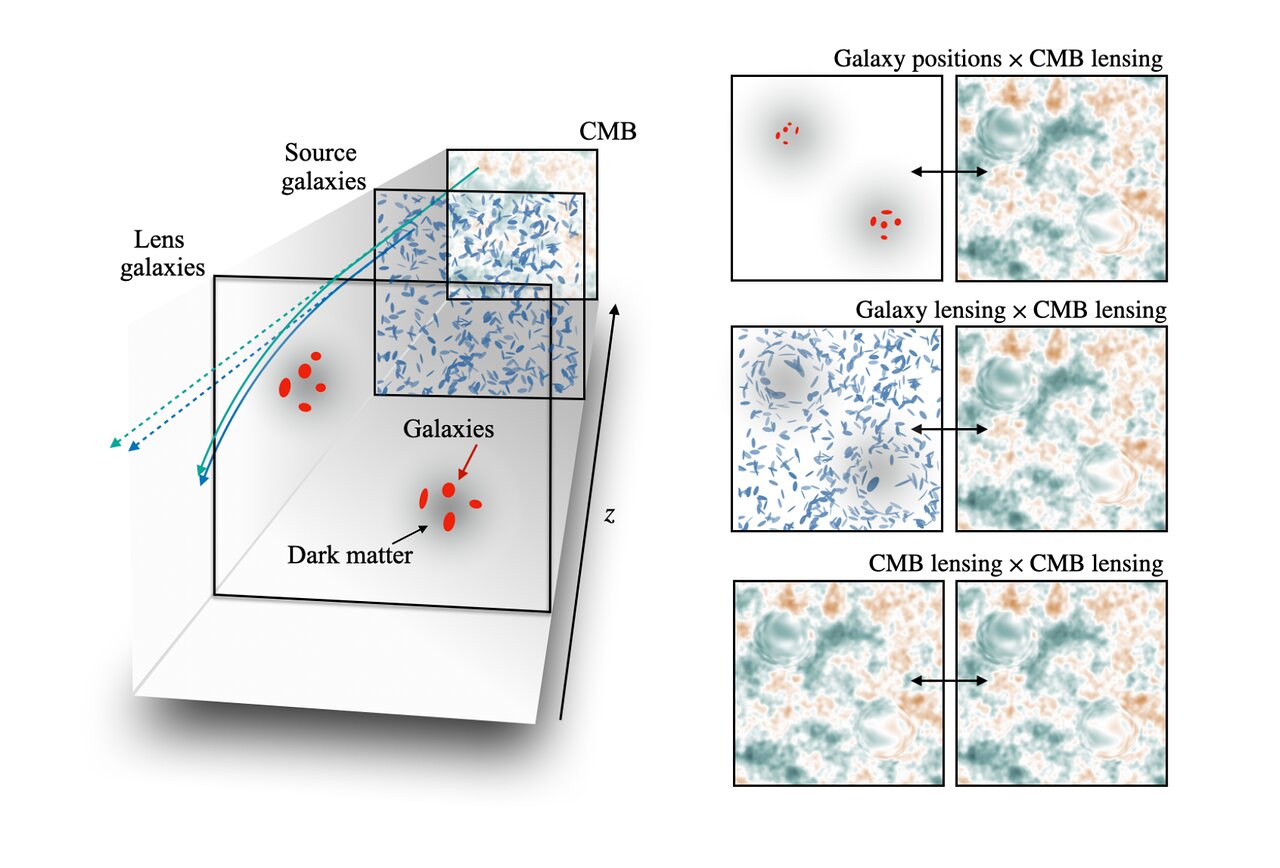
Tracing Dark Matter Across the Spectrum and Across the Cosmos
Two cosmological surveys of the southern sky combine forces to place powerful new constraints on the Standard Model of cosmology.
Profile
Name:
Location:
-
Cerro Tololo, Chile
Operational waveband:
-
Optical/Near-infrared
First light:
-
2012
Altitude:
-
2200 meters
Science goals:
-
Perform a deep and wide photometric survey of the southern Galactic cap with the primary goal of studying the nature of dark energy using four complementary probes: galaxy clusters, weak lensing, Type Ia supernovae (SNe Ia), and baryon acoustic oscillations. DECam has been used to study objects ranging from near-Earth objects to the high-redshift Universe.
10 March 2023
In 1933, Swiss-American astronomer Fritz Zwicky measured the mass of the visible members of a cluster of galaxies and found that their mutual gravitational attraction was much too small to keep the galaxies from flying apart. He concluded that there must be some other kind of matter that acted like a glue, holding the structure together. He named this substance dunkle Materie, or dark matter, as it was invisible to his telescope.
95% of the Universe is completely dark, with dark energy making up about 68% and dark matter about 27%. Only about 5% of the Universe — including the stars, planets and us — is made of familiar atomic matter.
Fast forward to 1978 when researchers at the Carnegie Institution of Washington, Vera C. Rubin — a pioneer for women in astronomy and the namesake of the Vera C. Rubin Observatory — and her colleague Kent Ford, saw something strange in their observations of the Andromeda Galaxy. Rather than the expected Keplarian motion that we see in our Solar System — with the inner planets moving faster than the outer planets as predicted by Kepler’s Law — Rubin and Ford found that the stars in the outer parts of the galaxy were rotating in lockstep with those closer toward the center. This led Rubin and Ford to the same conclusion that Zwicky had come to decades earlier: there must be large quantities of unseen matter distributed in and around the galaxies, holding them together. Though the astronomical community was reluctant to accept this conclusion at first, this behavior was observed in more and more galaxies until it could no longer be denied. Rubin’s work was key in laying the foundation for the model of the Universe that astronomers have since built.
“What they found was a remarkable success for the standard cosmological model, which assumes that most of the Universe is in the form of dark matter and dark energy.”
Later studies by NASA’s Wilkinson Microwave Anisotropy Probe satellite with microwave receivers designed by the Central Development Laboratory of the National Radio Astronomy Observatory not only supported the existence of dark matter, but also quantified just how much of it is out there. The Standard Model of cosmology assumes that the Universe, with all its matter and energy, was created in a singular event known as the Big Bang, which led to the expanding Universe [see earlier blog that explores the rate of expansion] as we see it today, and is now composed of about 5% ordinary matter, 27% dark matter, and 68% dark energy. And with these quantities defined, astronomers are now on a quest to map the distribution of matter, both visible and dark, to ultimately build an image of the structure of the Universe. A new study has brought astronomers one step closer to doing just that.
Mapping the distribution of all the matter in the Universe is not as simple as taking a 360-degree panorama of the night sky. There’s matter sitting at the edges of the cosmos that our telescopes simply are not powerful enough to see, especially when they have to look through swarms of gas, dust, and other cosmic debris. Not to mention the fact that 85% of matter is invisible! But astronomers have developed keen ways around this obstacle with the help of the Dark Energy Survey (DES) and the South Pole Telescope (SPT).
DES is a survey of the southern sky that maps the distribution of galaxies using the Dark Energy Camera (DECam), fabricated by the Department of Energy (DOE) and mounted on the Víctor M. Blanco 4-meter Telescope at Cerro Tololo Inter-American Observatory (CTIO), a Program of NSF’s NOIRLab, in Chile. Since dark matter is responsible for binding galaxies together, galaxies essentially act as signposts that say “Dark Matter Found Here!” The gravitational effects of dark matter can also curve space-time. So, using DES, astronomers can observe light from distant galaxies as it passes through regions of dark matter and measure the amount by which the light is bent en route — a technique called gravitational lensing. This method has allowed astronomers to map the distribution of dark matter in the nearby Universe.
For additional coverage of dark matter, dark energy, and our expanding Universe, see the AURA Blog “Our Mysterious Universe Still Evades Cosmological Understanding.”
However, at very large distances galaxies become increasingly faint and hard to detect, making it difficult to use them to trace the matter distribution. This is where the SPT comes in. The SPT is a 10-meter submillimeter telescope located at the Amundsen–Scott South Pole Station in Antarctica. Its task is to measure the cosmic microwave background (CMB) — a faintly glowing field of radiation that fills all of space. Just like light from the galaxies that DES observes, the light from the CMB — often referred to as the ‘echo’ of the Big Bang — is perturbed by the effects of dark matter, leading to small distortions in the CMB field. Since the CMB originates at a very large distance, the SPT can be used to map matter beyond the reach of galaxy surveys like DES.
Normally, with the dataset obtained from one of these surveys, astronomers will extrapolate specific parameters about the structure of the Universe and then compare them with the existing model. Whatever the results of the comparison, good or bad, it’s still difficult to draw any concrete conclusions because there is always the possibility of mistakes or bias. But, with the DES and SPT surveys, Eric Baxter with the Institute for Astronomy at the University of Hawai‘i and his University of Chicago collaborators Chihway Chang and Yuuki Omori, saw a unique opportunity. DES primarily observed the sky in the southern hemisphere, which coincides with the patch of sky that the SPT also observes. So, taking advantage of this overlap, Baxter and colleagues decided to combine the two data sets and then see how they match up with the existing model of the Universe.
“Using multiple datasets makes us less susceptible to errors because it is much more difficult for two separate data sets to be incorrect in the same way,” says Omori.
Baxter, Chang, and Omori, together with the international teams of several hundred collaborators from DES and the SPT, combined data from three years of observations by DES with the SPT survey, which ran from 2008 to 2011. What they found was a remarkable success for the standard cosmological model, which assumes that most of the Universe’s matter and energy are in the form of dark matter and dark energy.
“We think it is interesting that, with two completely different telescopes and observing techniques — an optical imaging telescope in Chile looking at galaxies and a millimeter-wave telescope at the South Pole looking at the oldest light from right after the Big Bang — we are able to extract the same message from the Universe that is consistent with the Standard Model of cosmology,” says Omori.
“And with the power of these two methods — and two datasets — astronomers can rejoice in the validation that the current modeling of the Universe is on the right track.”
Combining data from these distinct surveys not only increases the volume of the Universe that can be probed, it also provides constraints to the model that avoid the pitfalls of using one method alone. And with the power of these two methods — and two datasets — astronomers can rejoice in the validation that the current modeling of the Universe is on the right track.
However, cracks in this model may be starting to appear. Intriguingly, the joint analysis of the DES and SPT surveys supports previous claims that measurements of the matter distribution in the nearby Universe show fewer fluctuations than expected based on the standard cosmological model.
Determining whether hints of problems in the standard cosmological model are real or just chance will require more data. Fortunately, DES has three years of data that are waiting to be analyzed. At the same time, the SPT is performing a new survey of the CMB with dramatically improved sensitivity. A third telescope, the Atacama Cosmology Telescope (ACT), is also currently undertaking a new high-sensitivity survey of the CMB. By combining these new and improved data sets, Baxter and colleagues expect to obtain dramatically tighter constraints on the standard cosmological model in the near future.





